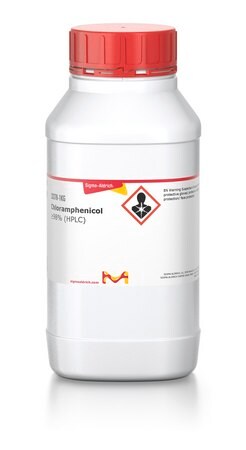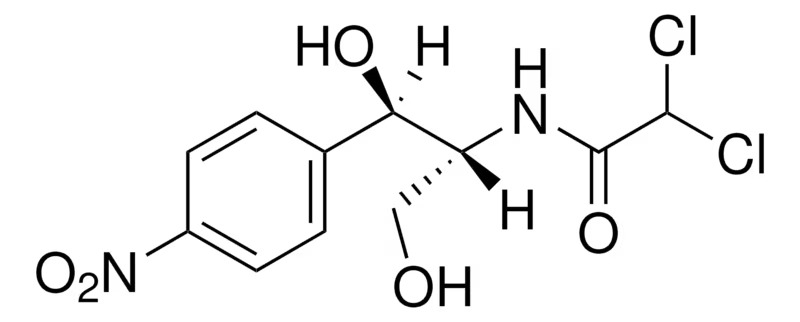Sigma-Aldrich Chloramphenicol, ≥98% (HPLC)
Catalog No :
CAS Number :
Brand :
In Stock
Specifications:
| Application | Cell culture | ||
| Storage Temperature | Ambient | ||
| Product Type | Antibiotic | Forms | Powder |
| Product Brand | Sigma-Aldrich | ||
| Product Grade | HPLC Grade, Cell Culture | Formula | Cl₂CHCONHCH(CH₂OH)CH(OH)C₆H₄NO₂ |
Sigma-Aldrich Chloramphenicol, ≥98% (HPLC) – High-Purity Broad-Spectrum Antibiotic
Validated for Molecular Biology, Microbiology, and Biopharmaceutical Applications
Sigma-Aldrich Chloramphenicol (≥98% HPLC, Powder/Crystals) is a broad-spectrum antibiotic widely used in microbiology, molecular biology, and bacterial selection assays. Originally derived from Streptomyces venezuelae, Chloramphenicol is an effective inhibitor of protein synthesis and is commonly used for bacterial selection, recombinant DNA technology, and research on antibiotic resistance mechanisms.
With its high purity (≥98%), this antibiotic is suitable for pharmaceutical research, antimicrobial susceptibility testing, veterinary microbiology, and biotechnological applications.
Key Features & Benefits
✅ High-Purity (≥98% HPLC) for Research & Biopharmaceutical Applications – Ensures reliable and reproducible experimental results
✅ Broad-Spectrum Antibiotic – Effective against Gram-positive, Gram-negative bacteria, mycobacteria, and mycoplasma
✅ Molecular Biology-Grade Reagent – Used for bacterial selection (10-20 µg/mL) and recombinant protein expression
✅ Mode of Action: Inhibits Protein Synthesis – Binds to 50S ribosomal subunit, preventing peptidyl transferase activity
✅ Stable at a Wide pH Range – Ensures long-term usability under optimal conditions
✅ Soluble in Organic Solvents – Dissolves well in ethanol, methanol, and DMSO
✅ Ideal for Bacterial Transformation & Selection – Commonly used in E. coli-based cloning systems
Technical Specifications
| Attribute | Details |
|---|---|
| Product Name | Chloramphenicol |
| Chemical Formula | Cl₂CHCONHCH(CH₂OH)CH(OH)C₆H₄NO₂ |
| Molecular Weight | 323.13 g/mol |
| Purity | ≥98% (HPLC) |
| Form | Powder or Crystals |
| pKa | 5.5 |
| Melting Point | 149-153°C |
| Storage Conditions | Room Temperature (Dry, Well-Ventilated Place) |
| Mode of Action | Inhibits bacterial protein synthesis at 50S ribosomal subunit |
| Antibiotic Spectrum | Gram-positive, Gram-negative, Mycoplasma, Mycobacteria |
| Solubility | Ethanol, Methanol, DMSO; Slightly Soluble in Water |
| Regulatory Compliance | For Research Use Only (RUO) |
Mechanism of Action & Resistance
Mode of Action:
- Chloramphenicol binds to the 50S ribosomal subunit, inhibiting peptidyl transferase activity and preventing the attachment of aminoacyl tRNA to the ribosome, thus blocking protein synthesis.
- Also inhibits mitochondrial and chloroplast protein synthesis, making it effective in plant cell culture applications.
Mode of Resistance:
- Chloramphenicol acetyltransferase (CAT) inactivates chloramphenicol by acetylation, preventing ribosomal binding.
- Efflux pumps and mutations in the 50S ribosomal subunit contribute to bacterial resistance.
Antimicrobial Spectrum:
✔ Gram-Positive Bacteria (Streptococcus spp., Staphylococcus spp., Bacillus spp.)
✔ Gram-Negative Bacteria (Escherichia coli, Salmonella spp., Klebsiella spp.)
✔ Mycobacteria & Mycoplasma
Applications
🔬 Molecular Biology & Genetic Engineering – Used for bacterial selection (10–20 µg/mL) in recombinant DNA technology
🦠 Microbiology & Antibiotic Resistance Studies – Effective for bacterial inhibition assays
⚗️ Protein Expression & Plasmid Selection – Ensures plasmid stability in bacterial cultures
🧪 Pharmaceutical Research & Drug Development – Supports new antibiotic formulations
🌱 Plant Cell Culture Research – Inhibits protein synthesis in mitochondria & chloroplasts
Preparation & Storage Guidelines
1️⃣ Preparation of Stock Solution
- Dissolve 50 mg/mL in ethanol, methanol, or DMSO for better solubility.
- Aqueous solutions degrade over time – use a borax-buffered solution to extend stability.
2️⃣ Recommended Working Concentrations
- Bacterial Selection: 10–20 µg/mL
- Plant Cell Culture Transformation: 20–50 µg/mL
3️⃣ Storage Conditions
- Store at room temperature in a dry, well-ventilated place.
- Protect from light & moisture to prevent degradation.
Ordering Information
| Pack Size | Catalog Number |
|---|---|
| 5 g | C0378-5G |
| 25 g | C0378-25G |
| 100 g | C0378-100G |
| 500 g | C0378-500G |
| 1 kg | C0378-1KG |
Regulatory & Safety Information
⚠️ For Research Use Only (RUO). Not intended for clinical or therapeutic applications.
⚠️ Light & Moisture Sensitive – Store in a dry, well-ventilated area.
⚠️ Use Protective Equipment (PPE) – Avoid direct skin contact & inhalation.
Why Choose Sigma-Aldrich Chloramphenicol (≥98%, HPLC)?
🔹 High-Purity Antibiotic (≥98%) for Reliable Research
🔹 Effective Against a Wide Range of Bacteria
🔹 Validated for Molecular Biology & Microbiology Applications
🔹 Stable at Room Temperature for Long-Term Storage
🔹 Available in Multiple Pack Sizes for Research Flexibility
For bulk orders, technical support, or additional information, contact LabMart Limited today. 🚀
- Pack Size: 1kg 100g 500g 5g 25g




 0
0



